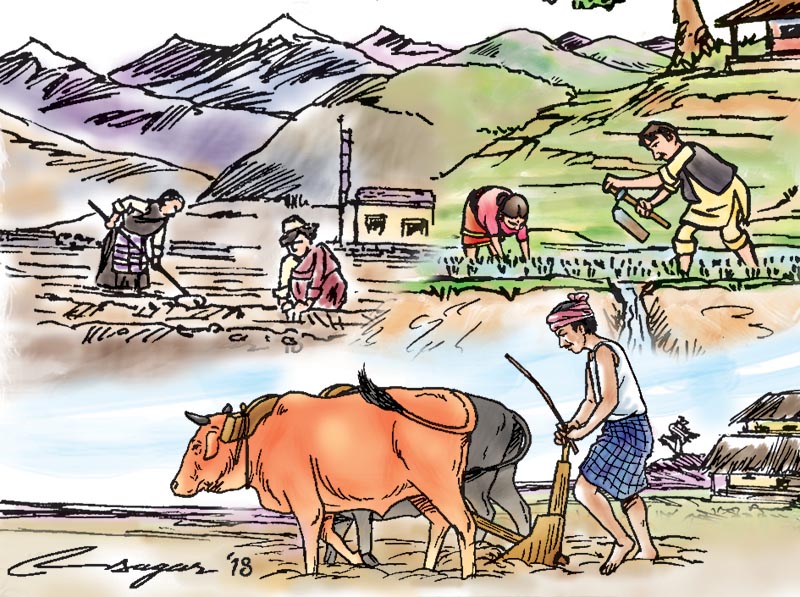Culture and agriculture: Understanding the link
The differences in the agricultural practices and food habits at three ecological regions in Nepal indicate that cultural and behavioural aspects of local people are key issues for sustainable development of agriculture
Agriculture has been the dominant economy of Nepal since cultivation of crops and domestication of animals originated in the country. Even today 60 per cent of the total population depends on agricultural lands for their livelihoods.
The word “agriculture” is derived from two Latin roots: “agri”, which means field, and “culture” which carries double meaning in English – cultivate or a way of life. The dual meaning of culture provides a special linkage between culture and agriculture.
So the cultivation of crops and domestication of animals are the ways of life of most of the pre-industrial people of the world including Nepal.
Since the very beginning, food production is resulting from the interactions of environment, technology and culture. Therefore the study of the environment and human element in agricultural activity is very important.
There are two major groups of people in Nepali society: Tibeto-Burman, or Mongoloids from the north, and Indo-Aryans from the south. Many customs and practices are inherited from both sides and have been influenced by the local factors such as land, climate and available resources. The types of people, crops grown and domesticated animals differ based on the ecological region, whereas the cultivation practices of crops and domestication of animals are influenced by the local culture.
In the high mountain areas, people are influenced by Tibetan culture and Thakalis, Sherpas and Bhotias live in separate, single, ethnic settlements. Climate varies from warm temperate to alpine.
Livestock production is based primarily on crops and grazing. Cultivation includes annual crops on rain-fed and irrigated land and perennial crops on uplands. The Sinhal goats of high altitude regions are reared for meat and pashmina. Sheep are reared for meat and wool.
Yaks are grazing livestock of higher altitudes. Grazing includes the migration of ruminant livestock and utilisation of vegetation. Potato, barley and buckwheat are the staple food crop. This zone lies in the lower ranges of the Himalayas from 2,500- 3,500 metres above the sea level. The land is steep and less fertile than in other zones.
In the mid-hills, people are more influenced by the predominant Hindu culture, and Brahman, Chhetri, Newars, Magars, Tamang, Rai, Limbu and Gurung live in multi-ethnic settlements.
Livestock, although an integral part of agriculture, is secondary to crops. Climate varies from subtropical to warm-temperate. Major cereal crops are paddy, wheat, maize and finger millet. Cattle, buffalo and goats are the main grazing livestock.
Cattle are reared for milk and draught. Goats are reared for meat. Hill farming systems are true examples of crop-livestock integration utilising forest resources for fodder.
This region lies at the elevation range of 500-2,500 metres above the sea level. Rice is the main crop in irrigated land followed by winter wheat. In the upland, maize is the main crop inter-cropped mostly with millet. Other cash crops such as potatoes, vegetables, fruits, tea, coffee, ginger and large cardamom that command higher prices, are slowly replacing maize crop.
The Tarai region is characterised by multi-ethnic settlements, predominantly influenced by Hindu culture. The land is flat and fertile and is suitable for the cultivation of rice, the major crop. The area – along the east-west direction in the southern part, occupies about 58 per cent of the cultivated land.
Rice, wheat, sugarcane, oilseed, vegetables and fruits are the common crops that provide about 80 per cent of the household income and dominate agricultural production in the Tarai. Cattle, buffaloes and goats are the main grazing livestock.
Cattle and buffalo are the sources of milk, manure and draught. Oxen are used for transport and cultivation. In many areas where massive deforestation has reduced the supply of firewood, dung is an important fuel.
In general, the composition of daily meal is either rice or wheat based. The main course of meal – Dal, Bhat, Tarkari” – is more or less perfect combination of carbohydrate, protein, vitamin, mineral and fat. It is a habitual way of having two main meals in a day. The morning meal is rice based, whereas evening meal is also rice based in the hilly area and wheat based in the Tarai.
Dal is well-cooked soup from different beans; Bhat is boiled rice; Tarkari is curried vegetables; pickle is prepared by fermenting seasonal vegetable or fruits; and curried or fried meat as a non-vegetarian food is eaten commonly in the hilly and mountainous areas. In the mountain region, porridge and boiled potato constitute the main course of
daily meals. Thus, the differences in the agricultural practices and food habits at three ecological regions indicate that cultural and behavioural aspects of local people are key issues for sustainable development of agriculture.
Agriculture development programmes of Nepal should consider local cultural practices, indigenous knowledge and climatic conditions for any change in a sustainable way.
Such considerations and values encourage a spirit of harmony between people, their natural environments and adoption of new technologies.
Kaini is former director general of Department of Agriculture






